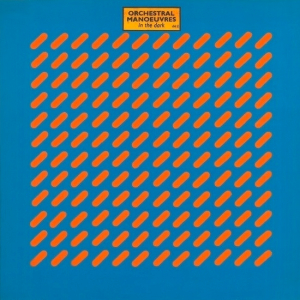
Orchestral Manoeuvres in the Dark (album)
Orchestral Manoeuvres in the Dark is the debut studio album by English electronic band Orchestral Manoeuvres in the Dark (OMD), released on 22 February 1980 by Dindisc. Recorded at the group's Liverpool studio, it showcased their minimal synth-pop style and peaked at number 27 on the UK Albums Chart. "Electricity" and "Red Frame/White Light" were released as singles; a re-recorded version of "Messages" provided OMD with their first hit in the UK, reaching number 13.
Orchestral Manoeuvres in the Dark
22 February 1980
1978–1979
Gramophone Suite (Liverpool)
37:42
- Orchestral Manoeuvres in the Dark
- Chester Valentino
Much of the album's content centres around war themes, with OMD exploring "the lengths to which people would go in a situation beyond the norm". A sleeper hit, Orchestral Manoeuvres in the Dark met with favourable reviews and became a seminal record of its era. The band expressed dissatisfaction with their production efforts on the album, although frontman Andy McCluskey later came to appreciate its "naivety". It was remastered and re-released in 2003 with six bonus tracks, including the single version of "Messages".
Orchestral Manoeuvres in the Dark is also the title of a 1981 compilation album of tracks from this release and OMD's second album, Organisation, issued only in the United States.
Artwork[edit]
The Orchestral Manoeuvres in the Dark sleeve was created by graphic designer Peter Saville and interior designer Ben Kelly, based on a door conceived by Kelly.[9] It featured a die-cut grid through which the orange inner sleeve was visible. Saville and Kelly won a Designers and Art Directors Award for their work.[9] McCluskey has praised the artwork, saying in 2019, "To this day, I think half the people bought [the album] for the Peter Saville sleeve."[1]
McCluskey stated that OMD did not fully understand the royalty system at the time, and that the band "had a sleeve that cost us so much to manufacture that for every record we sold we were barely earning pennies".[6] Carol Wilson of Dindisc disputed this, saying the cost to the band for the sleeve was contractually fixed and that the label took the expense.[9]
Legacy[edit]
Herald critic Nicola Meighan saw Orchestral Manoeuvres in the Dark as the first of "four vital, influential albums" from OMD, preceding Organisation (1980), Architecture & Morality (1981) and Dazzle Ships (1983).[29] Joseph Burnett of The Quietus identified it as "one of the key early British synth-based pop/rock albums";[30] PopMatters journalist Max Shand felt the record's "synthesizer bleeps disclos[ed] the way electronic music could avoid traditional song structures while still generating something buoyant."[7] In addition to being named by contemporary reviewers as one of the finest albums of 1980, Orchestral Manoeuvres in the Dark has appeared in subsequent lists of the year's best records, with Greg Reibman in Boston Rock placing it at no. 4.[31] Classic Pop readers voted it the 71st-greatest album of the 1980s,[32] while the magazine's editorial staff ranked it 26th among the decade's best debut albums.[33] Listeners of 89.3 The Current positioned the record at no. 291 in the "893 Essential Debut Albums".[34]
Orchestral Manoeuvres in the Dark was a formative influence on electronic group Depeche Mode.[14][35] Original bandleader Vince Clarke (who later founded Yazoo and Erasure) has cited the album as an inspiration during his early days as a synthesizer player,[36] with the track "Electricity" being his impetus to pursue a career in electronic music.[7][37] LCD Soundsystem's James Murphy "constantly" listened to the record, and follow-up Organisation, during the making of This Is Happening (2010).[38] Physicist and musician Brian Cox has named the album as a major influence and one of his all-time favourites.[39][40] Leftfield sampled "Almost" for their track "Snakeblood" (without attribution), which appeared on the soundtrack of The Beach (2000).[41][42]
Orchestral Manoeuvres in the Dark was publicly championed by rock group ZZ Top, who purchased and played it over the PA system at concert venues.[4][43] The record has also received endorsements from Pet Shop Boys vocalist Neil Tennant,[44] No Doubt bassist Tony Kanal,[45] and Spandau Ballet bandleader Gary Kemp, who found it to be "so ahead of its time".[46] U2 singer Bono recalled "[lying] on the bed, staring" at his poster of the album cover in the early 1980s.[47]